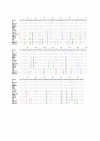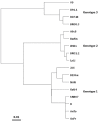Parvovirus B19 infection in Tunisian patients with sickle-cell anemia and acute erythroblastopenia
- PMID: 17961236
- PMCID: PMC2151067
- DOI: 10.1186/1471-2334-7-123
Parvovirus B19 infection in Tunisian patients with sickle-cell anemia and acute erythroblastopenia
Abstract
Background: Human parvovirus B19 is the etiologic agent of erythema infectiosum in children. It is also associated with other clinical manifestations in different target groups. Patients with chronic hemolytic anemia are at high risk of developing acute erythroblastopenia following infection by the virus. They usually become highly viremic and pose an increased risk of virus transmission. Close monitoring of such high risk groups is required for epidemiologic surveillance and disease prevention activities. Here we report a molecular epidemiological study on B19 virus infection in Tunisian patients with chronic hemolytic anemia.
Methods: This study was conducted on 92 young chronic hemolytic anemia patients who attended the same ward at the National Bone Marrow Transplantation Center of Tunis and 46 controls from a different hospital. Screening for IgM and IgG anti-B19 antibodies was performed using commercially available enzyme immunoassays and B19 DNA was detected by nested PCR in the overlapping VP1/VP2 region. DNA was sequenced using dideoxy-terminator cycle sequencing technology.
Results: Anti-parvovirus B19 IgG antibodies were detected in 26 of 46 sickle-cell anemia patients, 18 of 46 beta-thalassemia and 7 of 46 controls. Anti-parvovirus B19 IgM antibodies were detected only in 4 of the sickle-cell anemia patients: two siblings and two unrelated who presented with acute erythroblastopenia at the time of blood collection for this study and had no history of past transfusion. B19 DNA was detected only in sera of these four patients and the corresponding 288 bp nested DNA amplicons were sequenced. The sequences obtained were all identical and phylogenetic analysis showed that they belonged to a new B19 virus strain of Genotype1.
Conclusion: A new parvovirus B19 strain of genotype1 was detected in four Tunisian patients with sickle-cell anemia. Virus transmission appeared to be nosocomial and resulted in acute erythroblastopenia in the four patients. The possibility of independent transmission of this B19 variant to the patients is unlikely in light of the present epidemiological data. However this possibility cannot be ruled out because of the low genetic variability of the virus.
Figures



Similar articles
-
First report of serological, molecular detection, and characterization of human parvovirus B19 infections among sickle cell anaemia patients in Khartoum State, Sudan.J Infect Public Health. 2025 Apr;18(4):102682. doi: 10.1016/j.jiph.2025.102682. Epub 2025 Jan 27. J Infect Public Health. 2025. PMID: 39922088
-
Molecular and serological assessment of parvovirus B19 infections among sickle cell anemia patients.J Infect Dev Ctries. 2011 Jul 27;5(7):535-9. doi: 10.3855/jidc.1807. J Infect Dev Ctries. 2011. PMID: 21795822
-
[Acute erythroblastopenia due to Parvovirus B19 revealing hereditary spherocytosis].Arch Pediatr. 2011 Sep;18(9):990-2. doi: 10.1016/j.arcped.2011.06.009. Epub 2011 Aug 4. Arch Pediatr. 2011. PMID: 21820287 French.
-
A case of recurrent autoimmune hemolytic anemia during remission associated with acute pure red cell aplasia and hemophagocytic syndrome due to human parvovirus B19 infection successfully treated by steroid pulse therapy with a review of the literature.Int J Clin Exp Pathol. 2014 Apr 15;7(5):2624-35. eCollection 2014. Int J Clin Exp Pathol. 2014. PMID: 24966977 Free PMC article. Review.
-
Prevalence of parvovirus B19 infection in patients infected with human immunodeficiency virus.Clin Infect Dis. 1996 Dec;23(6):1255-60. doi: 10.1093/clinids/23.6.1255. Clin Infect Dis. 1996. PMID: 8953068 Review.
Cited by
-
Seroprevalence of parvovirus B19 antibodies and evidence of viremia among Nigerian patients with sickle cell anemia.J Biomed Res. 2013 Jul;27(4):272-82. doi: 10.7555/JBR.27.20120067. Epub 2013 Jun 15. J Biomed Res. 2013. PMID: 23885266 Free PMC article.
-
Disseminated Human Parvovirus B19 Infection Induced Multiple Organ Dysfunction Syndrome in an Adult Patient With Alcoholic Hepatitis Complicated by Hemolytic Anemia: A Case Report and Literature Review.Front Immunol. 2021 Dec 14;12:742990. doi: 10.3389/fimmu.2021.742990. eCollection 2021. Front Immunol. 2021. PMID: 34970255 Free PMC article.
-
Human Parvoviruses.Clin Microbiol Rev. 2017 Jan;30(1):43-113. doi: 10.1128/CMR.00040-16. Clin Microbiol Rev. 2017. PMID: 27806994 Free PMC article. Review.
-
Serological study on parvovirus B19 infection in multitransfused thalassemia major patients and its transmission through donor units.Asian J Transfus Sci. 2011 Jul;5(2):140-3. doi: 10.4103/0973-6247.83239. Asian J Transfus Sci. 2011. PMID: 21897592 Free PMC article.
-
Detection of Parvovirus B19 Infection in Thalasemic Patients in Isfahan Province, Iran.Jundishapur J Microbiol. 2015 Nov 8;8(11):e26590. doi: 10.5812/jjm.26590. eCollection 2015 Nov. Jundishapur J Microbiol. 2015. PMID: 26855745 Free PMC article.
References
-
- Plummer FA, Hammond GW, Forward K, Sekla L, Thompson LM, Jones SE, Kidd IM, Anderson MJ. An erythema infectiosum-like illness caused by human Parvovirus infection. N Engl J Med. 1985;313:74–79. - PubMed
-
- Kurtzman GJ, Ozawa K, Cohen B, Hanson G, Oseas R, Young NS. Chronic bone marrow failure due to persistent B19 parvovirus infection. N Engl J Med. 1987;317:287–294. - PubMed
Publication types
MeSH terms
Substances
LinkOut - more resources
Full Text Sources
Medical
Miscellaneous

